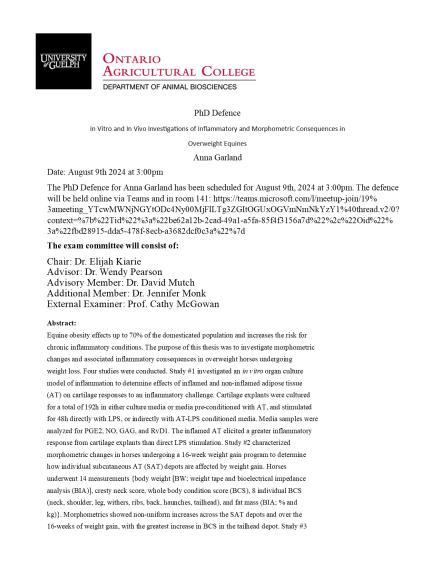Anna Garland's PhD Defence
Date and Time
Location
Room 141 and Teams: https://teams.microsoft.com/l/meetup-join/19%3ameeting_YTcwMWNjNGYtODc4Ny00MjFlLTg3ZGItOGUxOGVmNmNkYzY1%40thread.v2/0?context=%7b%22Tid%22%3a%22be62a12b-2cad-49a1-a5fa-85f4f3156a7d%22%2c%22Oid%22%3a%22fbd28915-dda5-478f-8ecb-a3682dcf0c3a%22%7d

Details
In Vitro and In Vivo Investigations of Inflammatory and Morphometric Consequences in Overweight Equines
Equine obesity effects up to 70% of the domesticated population and increases the risk for
chronic inflammatory conditions. The purpose of this thesis was to investigate morphometric
changes and associated inflammatory consequences in overweight horses undergoing
weight loss. Four studies were conducted. Study #1 investigated an in vitro organ culture
model of inflammation to determine effects of inflamed and non-inflamed adipose tissue
(AT) on cartilage responses to an inflammatory challenge. Cartilage explants were cultured
for a total of 192h in either culture media or media pre-conditioned with AT, and stimulated
for 48h directly with LPS, or indirectly with AT-LPS conditioned media. Media samples were
analyzed for PGE2, NO, GAG, and RvD1. The inflamed AT elicited a greater inflammatory
response from cartilage explants than direct LPS stimulation. Study #2 characterized
morphometric changes in horses undergoing a 16-week weight gain program to determine
how individual subcutaneous AT (SAT) depots are affected by weight gain. Horses
underwent 14 measurements {body weight [BW; weight tape and bioelectrical impedance
analysis (BIA)], cresty neck score, whole body condition score (BCS), 8 individual BCS
(neck, shoulder, leg, withers, ribs, back, haunches, tailhead), and fat mass (BIA; % and
kg)}. Morphometrics showed non-uniform increases across the SAT depots and over the
16-weeks of weight gain, with the greatest increase in BCS in the tailhead depot. Study #3
investigated morphometrics in overweight horses undergoing one of three weight loss
programs (daily exercise, feed restriction, and feed restriction plus daily exercise), or a
weight-maintenance group. During weeks 1, 5 and 10, horses underwent 14 measurements
(as described for study #2). Exercise-based programs produced greater reductions in
morphometrics than the feed restriction alone program. Study #4 investigated the
inflammatory consequences of each weight loss program to a standardized exercise test
(SET; Weeks 1, 5, 10). Blood plasma and synovial fluid were collected at -48h prior to the
SET, 1, 8, and 12h after cessation of the SET. Samples were analyzed for PGE2, NO, and
GAG. Exercise-based programs increased the inflammatory response to the SET in the
articulating joint, while feed restriction alone reduced the response.